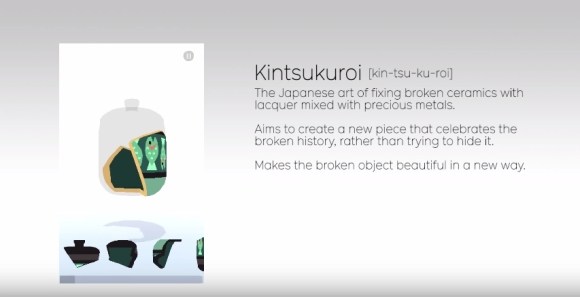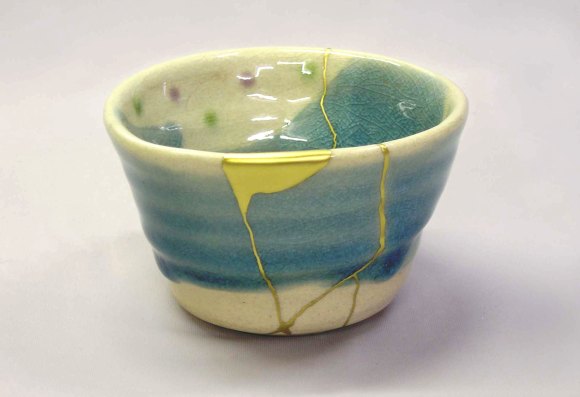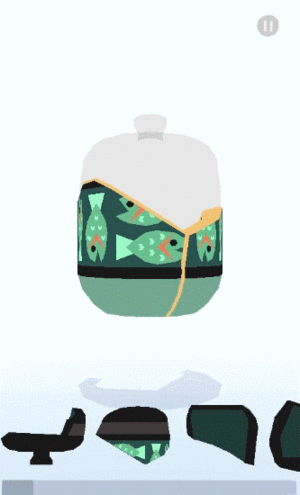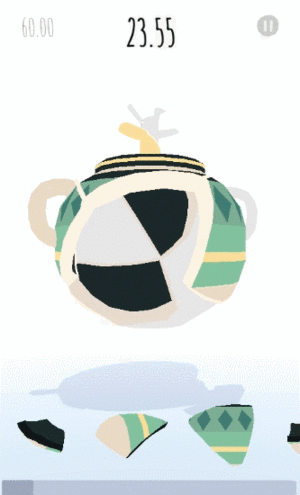
Do you think putting together broken bits of pottery sounds like fun? No, me neither. And I’d never imagine something that’s so tedious in real life would make a good basis for a game. However, that’s the theme behind this free Android app which draws upon an ancient Japanese philosophy and, after reading some reviews, I was convinced that I had to give it a go myself.
Kintsukuroi is a free game for Android devices made by British game developer Chelsea Saunders (also known as pixelatedcrown) and billed as “an Android experiment”. It’s been garnering some good reviews, and this one in particular intrigued me enough to try something that I’d usually pass over. While such artsy, Zen-inspired games are fashionable with the hipster crowd who pride themselves on always being one step ahead of digital trends, the concept of kintsukuroi has been around since way before smartphones and mobile gaming.
In Japanese philosophy and art there is a long-standing worldview and aesthetic called wabisabi, which celebrates the imperfect and accepts change. Compare that to the modern world, where we tend to look for perfection in products and throw things away as soon as we deem them worn out, and especially if they’re broken. Looking into Japan’s past traditions can offer an antithesis to this throw-away culture. Kintsukuroi, or kintsugi, is the Japanese art of repairing broken pottery with a kind of lacquer mixed with a precious metal such as gold. This makes the seams visible and incorporates the repair work into the design, showing that something broken can be remade as something beautiful.
Moving on from the lesson in Japanese aesthetics, the premise of the game is just as its name suggests; you put together the broken shards of the bowls, cups and vases to remake them into a whole again. To summarise it in just a few words, it’s a 3D, Zen-like jigsaw puzzle. You can rotate the outline of the object you’re putting together 360 degrees to inspect it, then rotate each piece a set number of ways and drag it to work out where it fits. When you hover over the right area it will highlight your piece, and when you let go it drops into place with a satisfying clink. The visual design is clean and minimalistic with white backgrounds so that you can focus completely on the task at hand.
There are 20 levels with both a timed and an untimed mode for each. The untimed mode is perfect for relaxation as you take your time while enjoying the lovely music and satisfying sound effects when rotating the pieces or fitting them into place. The timed mode’s music is slightly more invigorating, and the timer counting down can be quite nerve-wracking. The levels get more challenging as you go along, but never to the point of frustration. It’s not too difficult once you get the hang of rotating things, and since the piece lights up when you’re holding it in the right place you’ll never find yourself stuck for long. This means that it’s a very short game, but there is replay value in trying to get your times down as low as possible.
▼ The gameplay examples in this promotional video will give you a good idea of what it’s all about.
From its name to the ceramic designs, the game takes many inspirations from Japan. Even the music, by Clark Powell, includes traditional Japanese instruments. Saunders brings it all together in a neat little experience that can be enjoyed universally, and draws on the past while being distinctly modern. If you think this kind of Zen game is right up your street, then you can head on over to the Google Play store to download it for free. It’s a nice little distraction for when you have a few minutes to chill out and contemplate life, but don’t want to do so without your phone.
Sources: Android Experiments page, Chelsea Saunders, Kintsukuroi on Google Play h/t Vulcan Post
Top image: pixelatedcrown on YouTube
Insert images: Culture.gr.jp, Chelsea Saunders




 New Pokémon mobile game, Pokéland, announced, immediately enters alpha testing with 134 species
New Pokémon mobile game, Pokéland, announced, immediately enters alpha testing with 134 species Breakfast made beautiful by designer who creates stunning zen garden toast art and more【Pics】
Breakfast made beautiful by designer who creates stunning zen garden toast art and more【Pics】 Keep yourself entertained during long loo breaks with poo-themed mobile game【TGS 2015】
Keep yourself entertained during long loo breaks with poo-themed mobile game【TGS 2015】 I Hate You: Japan’s anime-style mobile romance game starring girls who will never, ever love you
I Hate You: Japan’s anime-style mobile romance game starring girls who will never, ever love you 2021’s top stories in Japanese food and cooking news【SoraNews24 Year in Review】
2021’s top stories in Japanese food and cooking news【SoraNews24 Year in Review】 Red light district sushi restaurant in Tokyo shows us just how wrong we were about it
Red light district sushi restaurant in Tokyo shows us just how wrong we were about it Historical figures get manga makeovers from artists of Spy x Family, My Hero Academia and more
Historical figures get manga makeovers from artists of Spy x Family, My Hero Academia and more Sandwiches fit for a sumo served up in Osaka【Taste Test】
Sandwiches fit for a sumo served up in Osaka【Taste Test】 McDonald’s new Happy Meals offer up cute and practical Sanrio lifestyle goods
McDonald’s new Happy Meals offer up cute and practical Sanrio lifestyle goods Japanese ramen restaurants under pressure from new yen banknotes
Japanese ramen restaurants under pressure from new yen banknotes Limited-edition Carbonara Udon will anger noodle purists and pasta lovers 【Taste test】
Limited-edition Carbonara Udon will anger noodle purists and pasta lovers 【Taste test】 Pokémon Sleep camping suite and guestrooms coming to Tokyo Hyatt along with giant Snorlax burgers
Pokémon Sleep camping suite and guestrooms coming to Tokyo Hyatt along with giant Snorlax burgers Akihabara pop-up shop sells goods made by Japanese prison inmates
Akihabara pop-up shop sells goods made by Japanese prison inmates Tokyo Tsukiji fish market site to be redeveloped with 50,000-seat stadium, hotel, shopping center
Tokyo Tsukiji fish market site to be redeveloped with 50,000-seat stadium, hotel, shopping center Beautiful Sailor Moon manhole cover coasters being given out for free by Tokyo tourist center
Beautiful Sailor Moon manhole cover coasters being given out for free by Tokyo tourist center All-you-can-drink Starbucks and amazing views part of Tokyo’s new 170 meter-high sky lounge
All-you-can-drink Starbucks and amazing views part of Tokyo’s new 170 meter-high sky lounge More foreign tourists than ever before in history visited Japan last month
More foreign tourists than ever before in history visited Japan last month French Fries Bread in Tokyo’s Shibuya becomes a hit on social media
French Fries Bread in Tokyo’s Shibuya becomes a hit on social media Studio Ghibli releases new action figures featuring Nausicaä of the Valley of the Wind characters
Studio Ghibli releases new action figures featuring Nausicaä of the Valley of the Wind characters New private rooms on Tokaido Shinkansen change the way we travel from Tokyo to Kyoto
New private rooms on Tokaido Shinkansen change the way we travel from Tokyo to Kyoto Starbucks reopens at Shibuya Scramble Crossing with new look and design concept
Starbucks reopens at Shibuya Scramble Crossing with new look and design concept Studio Ghibli glasses cases let anime characters keep an eye on your spectacles
Studio Ghibli glasses cases let anime characters keep an eye on your spectacles Beautiful Ghibli sealing wax kits let you create accessories and elegant letter decorations【Pics】
Beautiful Ghibli sealing wax kits let you create accessories and elegant letter decorations【Pics】 Studio Ghibli releases Kiki’s Delivery Service chocolate cake pouches in Japan
Studio Ghibli releases Kiki’s Delivery Service chocolate cake pouches in Japan New definition of “Japanese whiskey” goes into effect to prevent fakes from fooling overseas buyers
New definition of “Japanese whiskey” goes into effect to prevent fakes from fooling overseas buyers Our Japanese reporter visits Costco in the U.S., finds super American and very Japanese things
Our Japanese reporter visits Costco in the U.S., finds super American and very Japanese things Studio Ghibli unveils Mother’s Day gift set that captures the love in My Neighbour Totoro
Studio Ghibli unveils Mother’s Day gift set that captures the love in My Neighbour Totoro New Japanese KitKat flavour stars Sanrio characters, including Hello Kitty
New Japanese KitKat flavour stars Sanrio characters, including Hello Kitty New Pokémon cakes let you eat your way through Pikachu and all the Eevee evolutions
New Pokémon cakes let you eat your way through Pikachu and all the Eevee evolutions Disney princesses get official manga makeovers for Manga Princess Cafe opening in Tokyo
Disney princesses get official manga makeovers for Manga Princess Cafe opening in Tokyo Sales of Japan’s most convenient train ticket/shopping payment cards suspended indefinitely
Sales of Japan’s most convenient train ticket/shopping payment cards suspended indefinitely Sold-out Studio Ghibli desktop humidifiers are back so Totoro can help you through the dry season
Sold-out Studio Ghibli desktop humidifiers are back so Totoro can help you through the dry season Japanese government to make first change to romanization spelling rules since the 1950s
Japanese government to make first change to romanization spelling rules since the 1950s Ghibli founders Toshio Suzuki and Hayao Miyazaki contribute to Japanese whisky Totoro label design
Ghibli founders Toshio Suzuki and Hayao Miyazaki contribute to Japanese whisky Totoro label design Doraemon found buried at sea as scene from 1993 anime becomes real life【Photos】
Doraemon found buried at sea as scene from 1993 anime becomes real life【Photos】 Tokyo’s most famous Starbucks is closed
Tokyo’s most famous Starbucks is closed One Piece characters’ nationalities revealed, but fans have mixed opinions
One Piece characters’ nationalities revealed, but fans have mixed opinions We asked a Uniqlo employee what four things we should buy and their suggestions didn’t disappoint
We asked a Uniqlo employee what four things we should buy and their suggestions didn’t disappoint Princesses, fruits, and blacksmiths: Study reveals the 30 most unusual family names in Japan
Princesses, fruits, and blacksmiths: Study reveals the 30 most unusual family names in Japan Otaku husband returns home after argument to find wife has destroyed his anime robot collection
Otaku husband returns home after argument to find wife has destroyed his anime robot collection New smartphone game turns your photos of real-world cats into in-game warriors
New smartphone game turns your photos of real-world cats into in-game warriors Flipping genius? Japan is getting a new flip phone/smartphone hybrid【Photos】
Flipping genius? Japan is getting a new flip phone/smartphone hybrid【Photos】 Handy portable battery charging service now available in downtown Tokyo for just 108 yen
Handy portable battery charging service now available in downtown Tokyo for just 108 yen Kinoko Girly: the weirdest time-waster you’ll play all day
Kinoko Girly: the weirdest time-waster you’ll play all day One for the ladies: MMORPG “Avabel Online” brings female gamers together
One for the ladies: MMORPG “Avabel Online” brings female gamers together Ramen oil gathering game Ramen Oil Pecking Simulator coming to Steam soon!
Ramen oil gathering game Ramen Oil Pecking Simulator coming to Steam soon! Fed up of romance sims? Buddhist-themed visual novel coming to Android and iOS
Fed up of romance sims? Buddhist-themed visual novel coming to Android and iOS Banish your love rivals, fantasize over your crush’s recorder in weird new game app
Banish your love rivals, fantasize over your crush’s recorder in weird new game app Toyota’s wooden concept car serves as a time capsule for generations to come
Toyota’s wooden concept car serves as a time capsule for generations to come Mystery “nail house” discovered in Japan
Mystery “nail house” discovered in Japan If you have an apartment in Japan, your “fire disaster insurance” may also be toilet insurance
If you have an apartment in Japan, your “fire disaster insurance” may also be toilet insurance New Godzilla mobile game lets you raise your own Godzilla, race it against other monsters
New Godzilla mobile game lets you raise your own Godzilla, race it against other monsters We attempt to solve the Millennium Puzzle from Yu-Gi-Oh! ourselves, gain new respect for Yugi
We attempt to solve the Millennium Puzzle from Yu-Gi-Oh! ourselves, gain new respect for Yugi Romance an ancient Egyptian god in the newest bizarre dating sim for mobile
Romance an ancient Egyptian god in the newest bizarre dating sim for mobile Nintendo might be using Android to power its next games console
Nintendo might be using Android to power its next games console
Leave a Reply